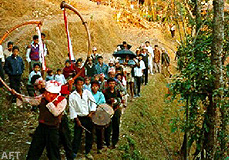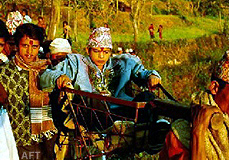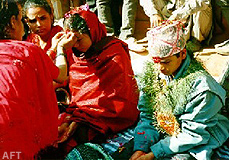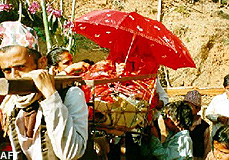|
Traditional
Village Weddings |
Author: Richard
K Rotto - USA
 |
| A
wedding party is traveling between villages fronted by the trumpeters |
| In
general, weddings vary from caste to caste and from region to region. For
example, weddings in the larger cities may have cars for parades; band
instruments (like trumpets and trombones), Christmas-like lights and electricity,
and in many cases more money. These weddings of course differ greatly from
the traditional remote village weddings. The pictures represent more the
traditional remote village wedding. Definitely the majority of weddings
fall into this category. |
|
The
wedding is a multi day event, which may engross an entire village.
In its essence, it reveals the very strong social and communal values of
the Nepali people. Few things in Nepali culture take precedence over a
wedding and most people treat the time as the opportunity that it is...a
time to stop and celebrate life with food, fun, and dancing.
Weddings
generally take place between people of fairly young age. It is more
the norm than exception for boys and girls to be married by the time they
are 16 or 17, many times even younger. Historically, girls purposely
had their marriages arranged before they started menstruating.
 |
| Groom goes to meet the bride in her village |
| The
wedding procedure usually begins with an arrangement of a boy and a
girl with comparable backgrounds, often with the help of a priest-type
matchmaker. A meeting then takes place between the parents of the two
parties. In an arranged marriage, it is the parents who choose their
children's partners. In a love marriage, it is the boy and the girl
who choose their mate. Today, both types can be found throughout the country
but it is the arranged marriage that predominates. |
|
However,
the love marriage method has been gaining much acceptance over the years
perhaps due to the influence of western culture.
One
additional note concerning the arranged marriage: even though the parents
choose the individuals, the children are commonly given a voice to accept
or decline the match. There are instances, however, of a couple not
seeing each other for the first time until the ceremony begins. Eloping
may occur between couples that are not thought to be a suitable match,
such as different castes. Though not much of an option in village life
is not unheard of in the larger more modern towns.
Castes
are in many ways an extended family. And there are cultural rules that
dictate that one must marry into the same caste, but not the same family.
There are many small villages today that are predominantly one family.
Therefore it is common that a one must look to neighboring villages to
marry. This explains why most village marriages are a marriage between
one person from one villlage and the other from another village sometimes
days apart. It also explains why marriages last many days as logistics
and travel prevent a single day event. As seen in the photo above, a wedding
party is traveling between villages fronted by the trumpeters which announce
the party around each bend, hill, and village along the trail.
After
the intitial marriage arrangement has taken place, the wedding begins with
a gathering of the traveling party at the groom's house. Celebrations are
made and rituals are performed with the local priest and the party then
travels to the bride's village. This party regularly consists of males
only. Once in the bride's village, the groom's family plays cards, the
priest performs the ceremony, and a big feast is eaten.
 |
| The
bride, after being given away by her mother |
| Here
the groom goes to meet the bride in her village as he is carried by the
wedding procession. The bride and groom by tradition are always carried,
either in a basket like this or by horse (if financially feasible).
The
bride, after being given away by her mother (in the photo) and father will
then travel to the groom's village to become a member of his family's household. |
|
Because
the Nepali way of life is one of agriculture and inheritance goes to the
sons, the married couple almost always live with the groom's parents. Traditionally
the couple will either inherit the parent's land and house (eldest son)
or eventually build their own house when feasible.
 |
| The
bride and herfather are travelingto the groom's village |
| The
ceremony is a very serious affair for the two young people. The bride is
dressed in red, which is the color for marriage. Often, she will shed tears
as the time to leave approaches. This may be a true feeling of apprehension
of leaving the home and family or it may be just a traditional requisite.
But many young girls cannot wait to leave the boredom of their life and
look forward to having a family of their own. |
|
 |
| Courtesy of
Association for Tourism, Nepal |
|



